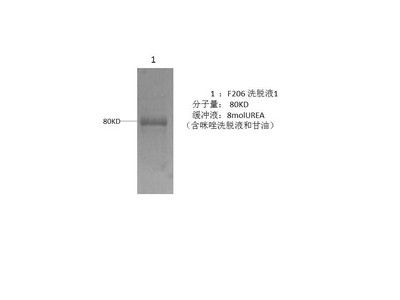- Home
- About
- Promotions
-
Products
-
Elisa Kits
- |
-
Primary antibodies
- |
-
Secondary antibodies
- |
-
Proteins
- |
-
IHC reagents
- |
-
WB reagents
- PonceauS Staining Solution
- PBST Washing Buffer, 10X
- 1.5M Tris-HCl Buffer, pH8.8
- 1M Tris-HCl Buffer, pH6.8
- 10% SDS Solution
- Prestained Protein Marker
- TBST Washing Buffer, 10X
- SDS PAGE Loading Buffer, 5X
- Stripping Buffered Solution
- Tris Buffer, pH7.4, 10X
- Total Protein Extraction Kit
- Running Buffer, 10X
- Transfer Buffer, 10X
- 30% Acr-Bis(29:1) Solution
- Tris电泳液速溶颗粒
- PBS(1X, premixed powder)
- TBS(1X, premixed powder)
- 快速封闭液
- 转膜液速溶颗粒
- Chemical reagents
- News
- Distributor
- Resources
- Contact
- Home
- >
- Info
- >
- Akt3 protein
- >
- Go Back
Akt3 protein
- Catalog No.:YD0072
- Applications:WB;SDS-PAGE
- Reactivity:Human
- Protein Name:
- Akt3 protein
- Sequence:
- Amino acid: 264-465, with his-MBP tag.
- Formulation:
- Liquid in PBS
- Concentration:
- SDS-PAGE >90%
- Storage Stability:
- -20°C/6 month,-80°C for long storage
- Other Name:
- RAC-gamma serine/threonine-protein kinase (EC 2.7.11.1) (Protein kinase Akt-3) (Protein kinase B gamma) (PKB gamma) (RAC-PK-gamma) (STK-2)
- Background:
- catalytic activity:ATP + a protein = ADP + a phosphoprotein.,domain:Binding of the PH domain to the phosphatidylinositol 3-kinase alpha (PI(3)K) results in its targeting to the plasma membrane.,enzyme regulation:Two specific sites, one in the kinase domain (Thr-305) and the other in the C-terminal regulatory region (Ser-472), need to be phosphorylated for its full activation.,function:IGF-1 leads to the activation of AKT3, which may play a role in regulating cell survival. Capable of phosphorylating several known proteins. Truncated isoform 2/PKB gamma 1 without the second serine phosphorylation site could still be stimulated but to a lesser extent.,PTM:Phosphorylated upon DNA damage, probably by ATM or ATR.,similarity:Belongs to the protein kinase superfamily.,similarity:Belongs to the protein kinase superfamily. AGC Ser/Thr protein kinase family. RAC subfamily.,similarity:Contains 1 AGC-kinase C-terminal domain.,similarity:Contains 1 PH domain.,similarity:Contains 1 protein kinase domain.,subcellular location:Membrane-associated after cell stimulation leading to its translocation.,subunit:Interacts (via PH domain) with TCL1A; this enhances AKT3 phosphorylation and activation.,tissue specificity:In adult tissues, it is highly expressed in brain, lung and kidney, but weakly in heart, testis and liver. In fetal tissues, it is highly expressed in heart, liver and brain and not at all in kidney.,
- Function:
- protein amino acid phosphorylation, phosphorus metabolic process, phosphate metabolic process, phosphorylation,
- Subcellular Location:
- Nucleus . Cytoplasm . Membrane ; Peripheral membrane protein . Membrane-associated after cell stimulation leading to its translocation.
- Expression:
- In adult tissues, it is highly expressed in brain, lung and kidney, but weakly in heart, testis and liver. In fetal tissues, it is highly expressed in heart, liver and brain and not at all in kidney.




